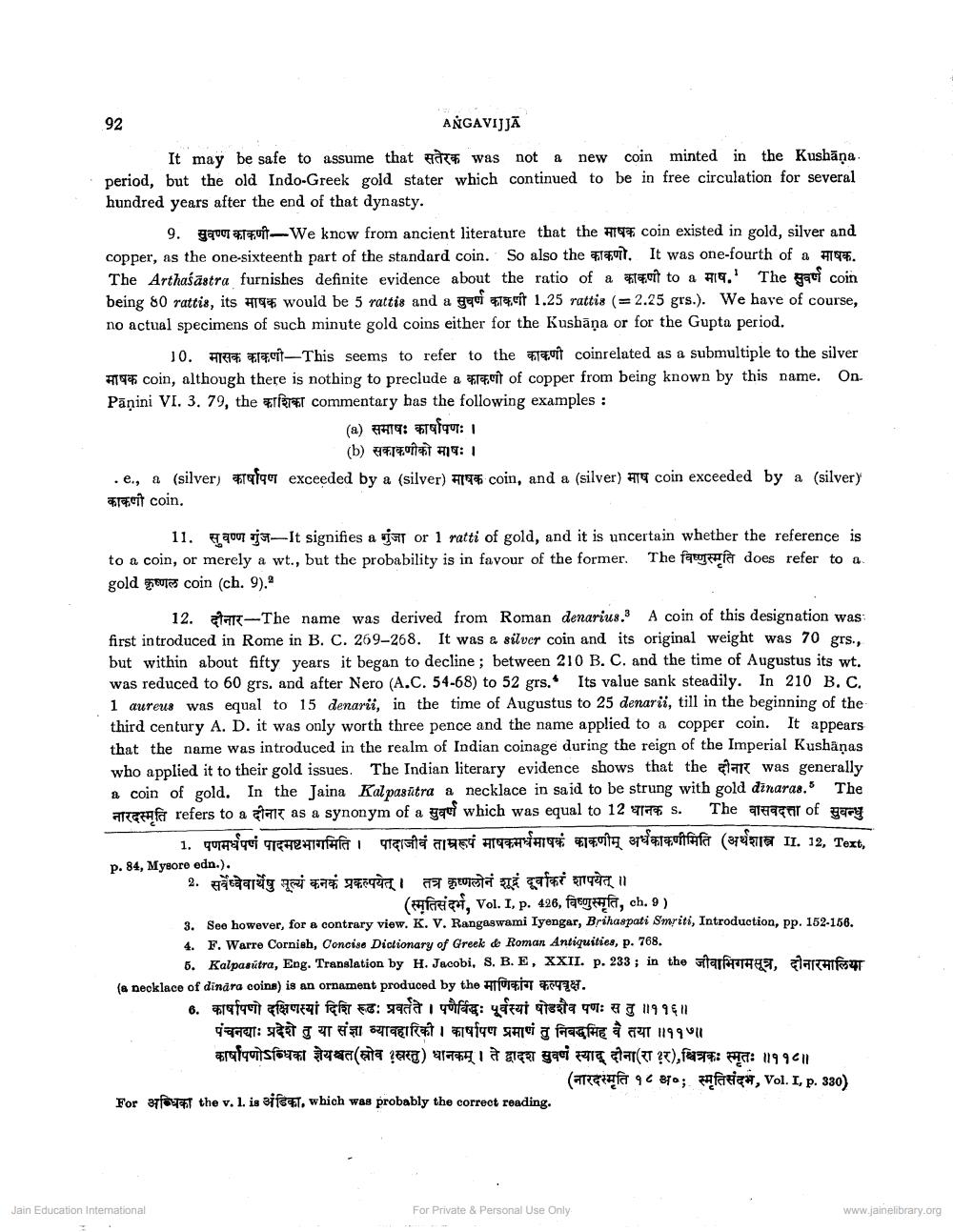________________
AŃGAVIJJĀ
It may be safe to assume that was not a new coin minted in the Kushāņa. period, but the old Indo-Greek gold stater which continued to be in free circulation for several hundred years after the end of that dynasty.
9. gautareuit-We know from ancient literature that the #1 coin existed in gold, silver and copper, as the one-sixteenth part of the standard coin. So also the 14t. It was one-fourth of a 19. The Arthaśāstra furnishes definite evidence about the ratio of a lot to a #19.' The gao coin being 80 rattis, its #19° would be 5 rattis and a goci ft 1.25 rattis (= 2.25 grs.). We have of course, no actual specimens of such minute gold coins either for the Kushāņa or for the Gupta period.
10. मासक काकणी-This seems to refer to the काकणी coinrelated as a submultiple to the silver H19coin, although there is nothing to preclude a rit of copper from being known by this name. On. Pāṇini VI. 3. 79, the Frierer commentary has the following examples :
(a) HTC: Fre94:
(b) 41% ) #19:1 .e., & (silver) fraqet exceeded by a (silver) 19% coin, and a (silver) ATC coin exceeded by a silver) काकणी coin.
11. quur jet-It signifies a jar or 1 ratti of gold, and it is uncertain whether the reference is to a coin, or merely a wt., but the probability is in favour of the former. The facufat does refer to a gold gutes coin (ch. 9).
12. -The name was derived from Roman denarius. A coin of this designation was first introduced in Rome in B. C. 269–268. It was a silver coin and its original weight was 70 grs., but within about fifty years it began to decline ; between 210 B. C. and the time of Augustus its wt. was reduced to 60 grs, and after Nero (A.C. 54-68) to 52 grs. Its value sank steadily. In 210 B.C. 1 aureus was equal to 15 denarii, in the time of Augustus to 25 denarii, till in the beginning of the third century A. D. it was only worth three pence and the name applied to a copper coin. It appears that the name was introduced in the realm of Indian coinage during the reign of the Imperial Kushanas who applied it to their gold issues. The Indian literary evidence shows that the glar was generally a coin of gold. In the Jaina Kal pasūtra a necklace in said to be strung with gold dinaras. The नारदस्मति refers to a दीनार as a synonym of a सुवर्ण which was equal to 12 धानक s. The वासवदत्ता of सुबन्धु 1. CC TEHEHNfHFT I Tarsi a1964 197HITË 1991tą p offufa (
S ia II. 12, Text, p. 84, Mysore edn.). 2. सर्वेष्वेवार्थेषु मूल्यं कनकं प्रकल्पयेत् । तत्र कृष्णलोनं शूद्रं दूर्वाकरं शापयेत् ॥
(foreizi, Vol. I, p. 426, fasgera, ch. 9) 3. See however, for a contrary view. K. V. Rangaswami Iyengar, Brihaspati Smriti, Introduction, pp. 152-156. 4. F. Warre Cornish, Concise Dictionary of Greek de Roman Antiquities, p. 768.
6. Kalpasútra, Eng. Translation by H. Jacobi, S. B. E, XXII. p. 233 ; in the aita , alarchi (a necklace of dindra coins) is an ornament produced by the aforet 19.
6. कार्षापणो दक्षिणस्यां दिशि रूढः प्रवर्तते । पणैर्विद्धः पूर्वस्यां षोडशैव पणः स तु ॥११६॥
पंचनद्याः प्रदेशे तु या संज्ञा व्यावहारिको । कार्षापण प्रमाणं तु निबद्धमिह वै तया ॥११॥ कार्षापणोऽब्धिका शेयश्चत(स्रोव ?स्ररतु) धानकम् । ते द्वादश सुवर्ण स्याद् दीना(रा ?र),चित्रकः स्मृतः ॥११॥
(atestufe 9C 870; Fafazięá, Vol. I, p. 330) For afy the v. 1. is aife, which was probably the correct reading.
Jain Education Interational
For Private & Personal Use Only
www.jainelibrary.org




